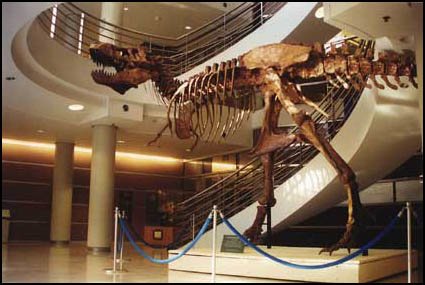|
Who Dug That t-rex
TYRANNOSAURUS REX! Just about two dozen good specimens of these animals have been found and these finds are from highly restricted areas in western North America. Henry Fairfield Osborn, of the American Museum of Natural History in New York City, first described Tyrannosaurus rex in 1905. This first specimen of Tyrannosaurus is now on display at the Carnegie Museum of Natural History in Pittsburgh, Pennsylvania. The skeleton on display at UCMP is a cast of a skeleton (excavated in 1990) now in the Museum of the Rockies in Bozeman, Montana. Skeletons of a close relative of T. rex, Tarbosaurus, have been found in Mongolia. Clearly this animal was imposing in size and stature. In fact, T. rex was one of the largest terrestrial carnivores of all time. It stood approximately 15 feet high and was about 40 feet in length, roughly six tons in weight. In its large mouth were six-inch long, sharp, serrated teeth. Good T. rex specimens, however, are hard to come by Berkeley's mount is 90% complete, one of the best specimens found to date. Some 1520 other specimens around the country range from about 10% to 80% complete; missing ribs and tail bones are common. T. rex: Scavenger or Predator? Paleontologist Jack Horner of the Museum of the Rockies (Bozeman, MT) has proposed that T.rex could not have been a predator. His arguments against predation include its small eyes (needed to see prey), small arms (needed to hold prey), huge legs (meaning slow speed) and that there is no evidence for predation bones have been found with tyrannosaur teeth embedded in them or scratched by them, but so far no study has shown that tyrannosaurs killed other dinosaurs for food (a bone showing tyrannosaur tooth marks that had healed would be strong evidence for predation). His evidence supporting scavenging include its large olfactory lobes (part of the brain used for smell), and that its legs were built for walking long distances (the thigh was about the size of the calf, as in humans). Vultures have large olfactory lobes and are good at soaring to cover long distances. There are arguments against scavenging. Most large living predators (such as lions and hyenas) do scavenge meat happily when it is available, but most do prefer fresh meat. Dr. Horner argues that its arms were too weak to grab prey, but sharks, wolves, snakes, lizards and even many birds are successful predators without using their forelimbs (if any). Whether T.rex was a slow animal is tough to tell, as our dinosaur speeds page will tell you. What is the public to think of all this? It is suggested that you make up your own mind; the fact is that reconstructing the behavior of extinct animals is difficult, especially when there are no close modern relatives with which to compare them. Tyrannosaurs may have been scavengers, predators or both; Dr. Horner is merely presenting an opposing argument that shows that we are not yet 100% sure what ecological niche the great tyrannosaurs filled. 
|
